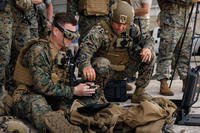The Marine Corps' new uncrewed, semi-submersible vessel -- dubbed the "narco-boat" -- arrived in Japan earlier this month as part of an ongoing modernization effort aimed at supplying Marines across the Indo-Pacific.
The Autonomous Low-Profile Vessel, or ALPV, is a roughly 60-foot-long watercraft meant to lurk with a low profile on the water to avoid detection and deliver logistics to Marine units dispersed on islands throughout the region.
A spokesperson for the III Marine Expeditionary Force told Military.com on Wednesday that the vessel arrived at Naha Port -- a military facility on the western side of Okinawa -- earlier this month and will deploy around coastal waters of the Japanese island for roughly 11 months.
Read Next: Search for Navy Crew of Crashed Growler Aircraft Underway in Washington State
Leidos, the "narco-boat's" manufacturer, announced in March that it delivered two of the vessels to the Marine Corps in 2023. The ALPV is meant to support logistics operations in the Indo-Pacific amid the Marine Corps' greater reorganization effort, also known as Force Design.
"The physical need for Marines to move supplies and ammunition remains a constant challenge," Capt. Pawel Puczko, a spokesperson for III MEF, told Military.com in an email on Wednesday. "The ALPV is an autonomous logistics delivery system that can lighten the Marines' physical load, provide supplies at the critical point of need, and transfer ... various classes of supplies across vast distances in the maritime environment."
Leidos said the ALPV can transport up to five tons of supplies across a range of 2,000 nautical miles, according to the March announcement.
The Diplomat, a news magazine that covers the Indo-Pacific, reported Friday that the ALPV deployed for the first time out of the Naha Port on Oct. 9, citing Okinawa officials -- the first time the "narco-boat" was used in Japan.
When asked by Military.com, the Marine Corps did not confirm that the vessel launched on that date, but said that it had plans to release photos "from the ALPV operating around Okinawa in the coming days," Puczko said.
"This is one potential technology the Marine Corps can use to provide sustainment to stand-in forces operating within contested areas and an example of the Marine Corps leveraging the latest advancements in autonomous systems to increase warfighter lethality, improve all domain sensing, and create survivable sustainment, bringing the service into the next generation of warfare," Puczko said.
Puczko said that various units within III MEF use the ALPV, but did not disclose details about specific cargo or movements to "protect operational security."
The March Leidos press release said the Marine Corps tested the ALPVs during an exercise in California this year. The design was compared to vessels used by smugglers, a Marine Corps leader said in September.
"Truth be told, this is just a narco-boat," Marine Corps Brig. Gen. Simon Doran, head of the service's warfighting laboratory, said during a conference last month, according to Marine Corps Times. "We stole the idea from friends down south ... It can carry pretty much anything you want to put in it."
Related: Using New Missile, Marine Corps Attack Helicopter Sinks Mock Vessel During Pacific Test














